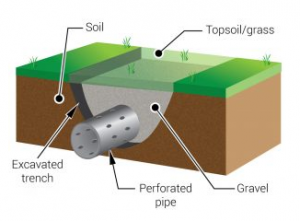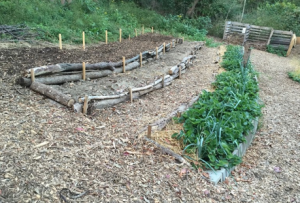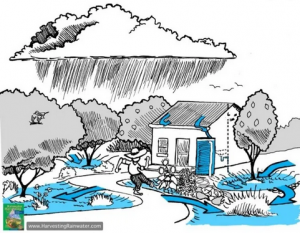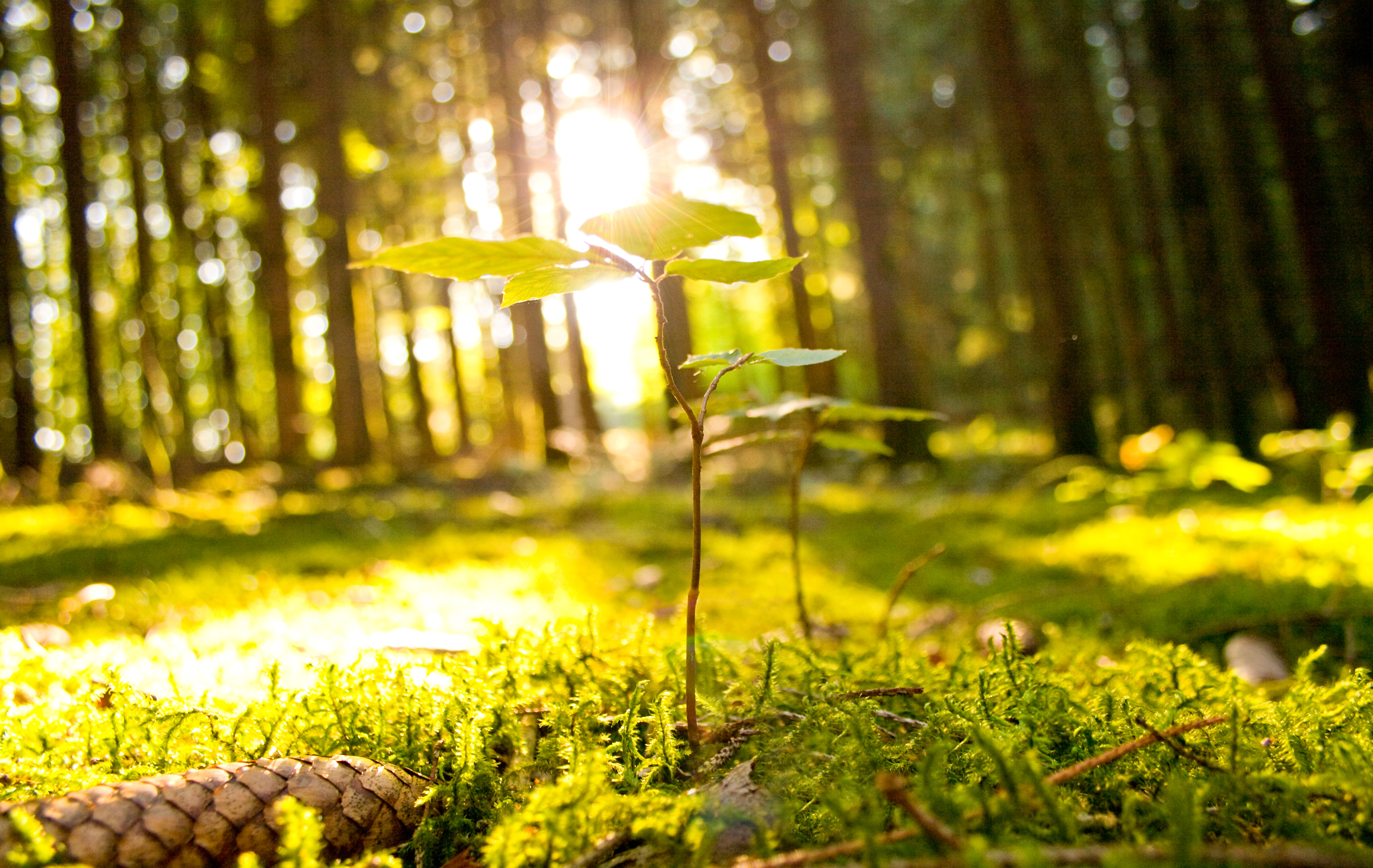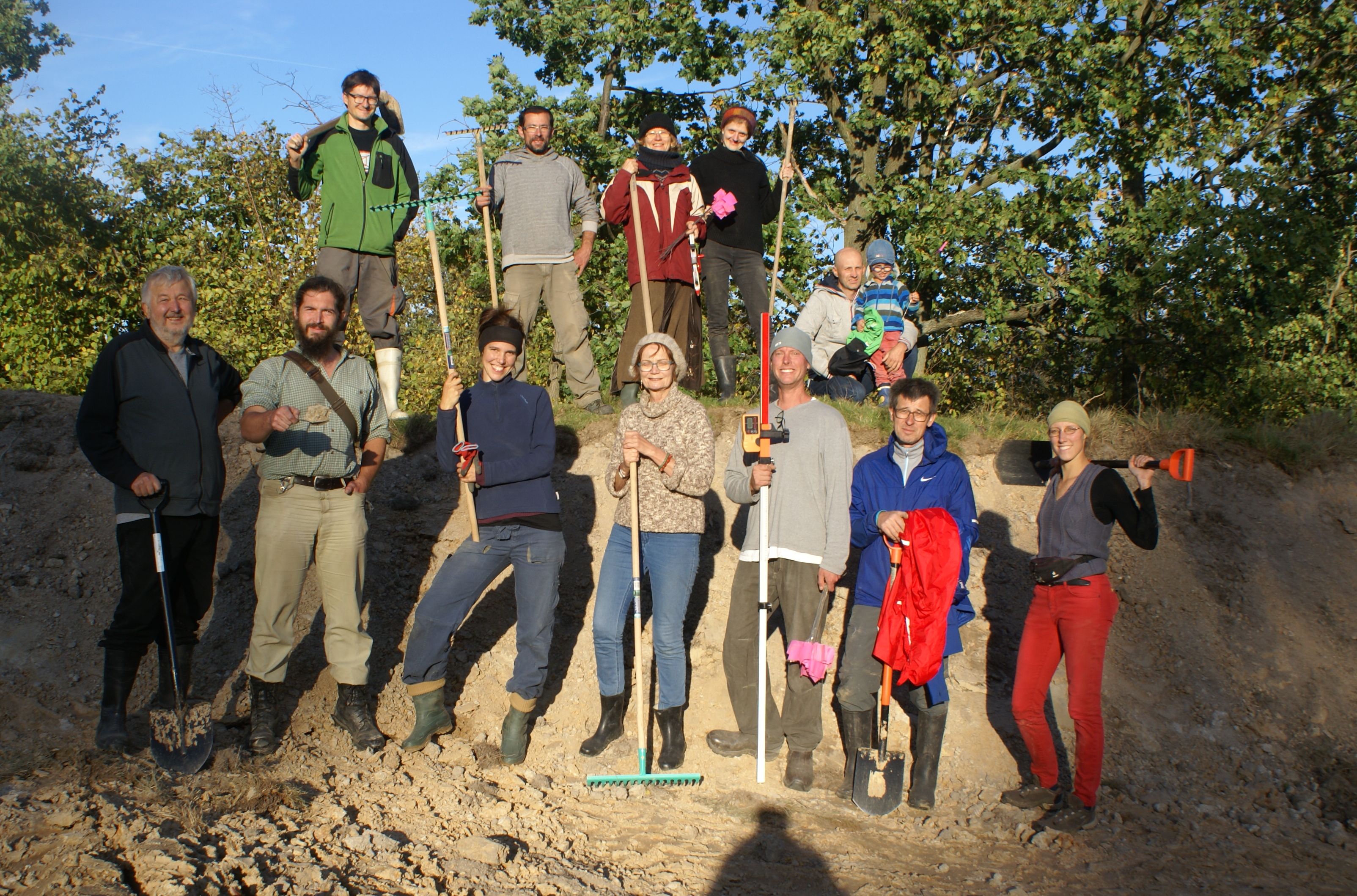
Water retention techniques
We’d like this site to become a rich source of information with regards to water retention techniques. There are so much resources already available on the internet and in books like Brad Lancaster’s Rainwater Harvesting for Drylands and Beyond that one can get lost (in reading) endlessly. We tried to pull together some of the most promising techniques suitable for European temperate climate as a summary – it is a living list thus feel free to send comments and suggestions what else to include. Please see our other post about the Visegrad water resilience project we have been running in 2019 – thanks to the financial support of:

Swales
What is it?
Swale is a ditch dug on contour for the purpose of catching rainwater and slowing it down so that it can sink slowly into the landscape. Instead of water running off or pooling above ground, swales direct it downward into an underground reservoir (as on the picture). Thanks to this, the water that would normally run-off in degraded landscape, cause more erosion and fail to feed plants has a chance to get incorporated into the cycle of life.

This underground reservoir attracts microorganisms. Suddenly the soil is alive, and organic matter is being created. The more the organic matter builds, the more moisture it holds and the better the system can withstand both floods and droughts.
Swales are a permanent earthwork features – they can be applied on large farms but also at a residential scale. Their benefits include: mitigating storm water runoff; easier and more efficient way to catching rain than using a tank or barrel; and building self-sustaining ecosystems (trees on the berms).
However, swales aren’t always appropriate so their use should be thought through as they may create damage. By placing a swale somewhere, you are going to make the ground downhill of the swale wetter – creating conditions that could make the ground unstable, even triggering a landslide. Also, any area with more than a fifteen-degree slope (about 1:3.75) isn’t appropriate for installing swales, as the water saturation may cause slides, which could be dangerous. Another risky scenario are earthworks that infiltrate excessive water on slopes with impervious layers under shallow soils: the top layer of soil can just slide away. Furthermore, sandy slopes, if saturated, and recently burned slope are all risk factors because an unusually heavy rain or hot days in early spring that rapidly melt snowpack may cause sliding. So in steep slopes and when sliding is a danger (e.g. in tropical highlands, quick clay / sandy slopes), avoid swales. Other, less intensive earthworks (e.g. Keylines) might make more economic and ecological sense.
How is it done?
One needs to create a a shallow trench dug along the land’s contour, with a berm on the downhill side created with soil from the trench. All points along a contour line are exactly the same height above sea level. The basic plan of action include:
- Observe and research: what kind of slope do you have? Which way does the water flow? What kind of soil do you have? How much rainfall do you get?
- Plan on a contour map where the swales will be
- Mark the contour lines with laser, optic or bunyip level
- Dig a ditch along this line (size of the ditch depends on amount of water you want to catch
- Extra soil from excavation place below the ditch in a form of a berm – that will help you to store even more water
- Plant the berm with perennial plants, preferably including trees and seed everything with cover plants or mulch to promote the right soil structure
Resources
https://www.youtube.com/watch?v=0wETVPEkHso https://www.tenthacrefarm.com/how-to-build-swale https://permaculturenews.org/2010/01/07/use-of-small-swales-a-case-study/
Check dams
What are they?
These dams are small dams used within drainages to reduce downstream flooding and erosion. Check dams are an ancient technique dating from the second century A.D. Often more check dams are appropriate for a watershed and their implementation should be started in the upstream of catchments. Their benefits include i) being inexpensive and easy to install; ii) reducing velocity of water flow; iii) prevent erosion from occurring; and iv) settle sediments and pollutants. Check dams should only be constructed in watercourses or permanently flowing streams with a specific design not to restrict fish passage.
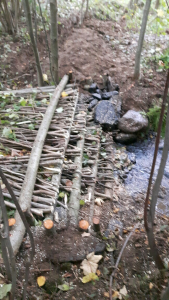
How are they made?
There are several designs for how check dams could be constructed. They are built across (perpendicular to) the gully bed. Different materials could be used including woven-wire, brushwood, logs, loose stone and boulders to build check dams. Exact procedures and steps can be found in the resources section.
Resources:
https://sswm.info/sswm-university-course/module-4-sustainable-water-supply/further-resources-water-sources-hardware/check-dams-&-gully-plugs https://stormwater.pca.state.mn.us/index.php?title=Check_dams_for_stormwater_swales https://www.youtube.com/watch?time_continue=75&v=hy_zDXGvhP8&feature=emb_logo
French drains
What is it?
It’s a trench or basin filled with porous material such as gravel, stone, rough organic matter like bark or containing a perforated pipe in order to redirect surface water. Thanks to the ample spaces between these materials, water can infiltrate quickly down into the drain and sink into the root zone and the surrounding soil. It also ensures that people can walk on it. They are especially good for draining an area that hold too much water and redirecting the water to where it is useful
How is it done?
The basic idea is that you dig a trench that is sloping in the direction in which you want the water to flow. Then, you fill that ditch with gravel or other porous material.
You might want to use the perforated pipe, in which case you place that pipe inside the ditch before putting the gravel in. More detailed instructions in the Resources section below
Resources
https://www.youtube.com/watch?v=eRL_5G9c08s https://www.wikihow.com/Build-a-French-Drain
Mulching
What is it?
Mulching is covering the surface of the soil with organic material like wood chips, sawdust, straw, leaves, compost etc. Thanks to a layer of organic matter on the surface, the water from the soil doesn’t evaporate so quickly and the microclimate is created that is not only more humid and cool but it also serves as a great environment for the soil organisms to live and improve the soil, which can then hold even more water. As the mulch decomposes it becomes an excellent source of food for the bacteria and organisms living in the soil, enhancing the soil quality. Mulch deters weed growth, and when used over time, revitalizes soil and promotes better plant growth.

How is it done?
Mulching can be done in several ways: organic matter (such as woodchip, straw, hay or leafmold) can be placed around plants and will eventually rot down into the soil improving its structure. Alternatively, sheet mulches (such as cardboard or permeable black plastic) can be used or even more permanent materials (such as slate, stones or gravel). It can be as simple as placing the organic matter on top of the soil. The important things are:
- not to put the mulch so close to the trunk or stem of a plant that it would touch it, because that can cause rotting.
- to be mindful about the seeds of unwanted plants that can come with compost or hay.
- not to use fresh manure that could burn the plants
Resources
Mulching in the permaculture garden : https://www.tenthacrefarm.com/mulching-in-the-permaculture-garden/
5 ways in which organic mulching helps your garden: https://growagoodlife.com/organic-mulch-helps-your-garden/ Beginner’s guide : https://getbusygardening.com/mulching-vegetable-garden/ 6 methods for mulching : https://weingartz.com/expert-advice/2017/06/6-methods-for-mulching/
Terraces
What is it?
Terrace is a landform created on a slope by building a wall that holds soil creating a flat surface for cultivation and acts as a swale by holding water at the same time. They are usually done for the slopes above 18-20%, when the swales are no longer effective.
How is it done?
There are different kinds of terraces and ways to do them. The basics are:
- Observe: is the sloping high enough to justify the use of a terrace? (>18%)
- Mark the contour line which will be the edge of the terrace
- Build a wall supporting the wall from wood, stones or other material. Or landscape to create the terrace with soil only (wall being properly banked soil)
- Fill the terrace with soil and organic matter where appropriate.
- Plant.
Resources
Build a check-log terrace : https://www.tenthacrefarm.com/quick-terrace-hill/
More detailed step-by-step : https://www.youtube.com/watch?v=zeDYPXpwvus
Designing small and big scale : https://treeyopermacultureedu.com/chapter-9-earth-working-and-earth-resources/terraces/
Ponds
What is it?
Pond is a body of water that holds water. They can be natural, enhanced by humans or completely artificially made. We will focus here on artificially made ones. Their purpose is to collect and store the water as well as enrich the local ecosystem by introducing a water-rich environment.
How is it done?
Pond designs vary depending on the topography, the water catchment area and the objectives of the pond installation. Smaller ponds can be even dug by few You can find some more information about that in the Resources below
Resources
Installing a small pond for irrigation and wildlife (by Balkan Ecology Project): https://balkanecologyproject.blogspot.com/2017/04/small-pond-installations-for-irrigation.html
Podcast on building dams and ponds: https://www.permaculturevoices.com/building-dams-ponds-and-rehydrating-the-landscape-the-water-retention-landscape-with-zach-weiss-pvp109/
Rainwater harvesting
What is it?
Rainwater harvesting is a practice of collecting and storing rainwater. When done well and in the place with sufficient rainwater, it can provide a household with all the water that is needed for the domestic and irrigation uses.
How is it done?
It can be done in many ways, depending on the particular situation but the general idea is to collect the water that falls on the roof and the roads and direct it to a storage from which it can be used when needed.
Resources
23 DIY Rainwater harvesting systems : https://morningchores.com/rainwater-harvesting/
Rainwater harvesting guide : https://commonsensehome.com/rainwater-harvesting/
Example of a rainwater harvesting system: https://www.youtube.com/watch?v=gPJFa2KUoUc
More ways of collecting rainwater : https://www.wikihow.com/Collect-Rainwater
Keyline Design
What is it?
Keyline design is design method focused on maximizing the beneficial use of the water resources on a land. The “keyline” stands for a specific topographic feature related to the natural flow of water on the land. It is a system of principles and techniques of developing rural and urban landscapes to optimize use of their water resources.

How is it done?
Some of the basic tools for keyline designs are :
- Scale of permanence, that guides us in terms of what structures should be focusing on first, therefore – what we should be designing around.
- Keylines – which are lines on the land that are slightly off contour. Using them to design things like roads, tree lines, swales, irrigation ditches etc. helps the water to spread better in the landscape
Resources
What is Keyline Design by Richard Perkins: http://www.ridgedalepermaculture.com/keyline-design.html
More detailed information on many aspects of Keyline Design: http://crkeyline.ca/what-is-keyline-design/
In the context of regenerative agriculture: https://www.youtube.com/watch?v=UOR5JUOMmQQ
About scale of permanence: https://www.youtube.com/watch?v=8coPmuWpUP8

